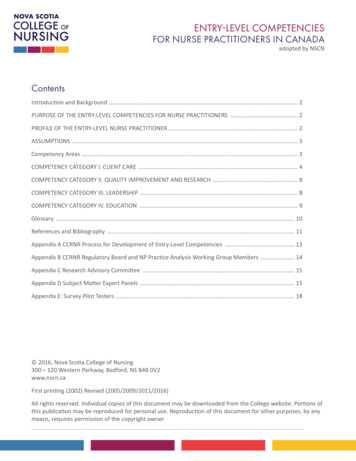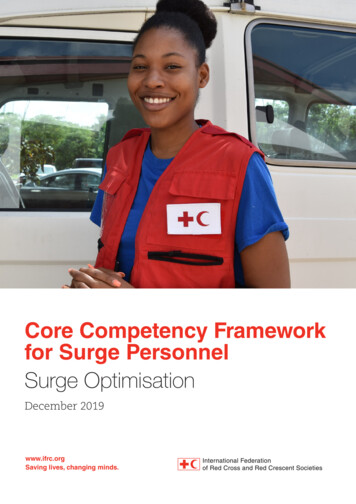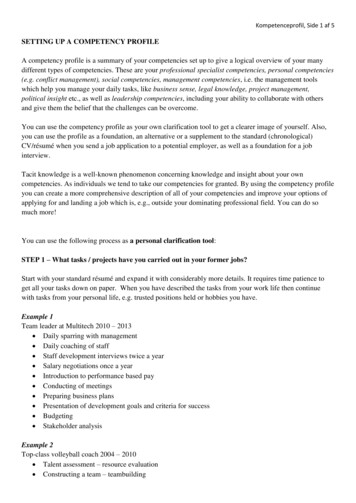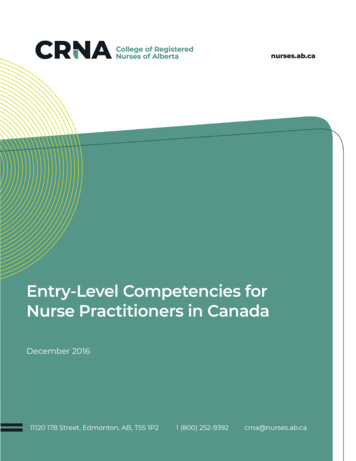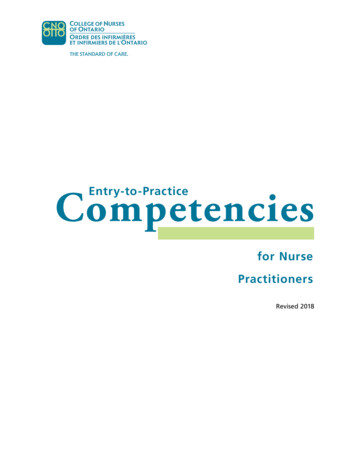
Transcription
CompetenciesEntry-to-Practicefor NursePractitionersRevised 2018
Table of ContentsIntroduction3Background3Purpose3Profile of the Nurse Practitioner3Assumptions3Entry-Level Competencies3Competency Category4I. Client CareA. Client Relationship Building and CommunicationB. AssessmentC. DiagnosisD. ManagementE. Collaboration, Consultation, and ReferralF. Health PromotionII. Quality Improvement and ResearchIII. LeadershipIV. Education4444566677References and Bibliography8Appendix A: CCRNR Process for Development of Entry LevelCompetencies10Appendix B: Nurse Practitioner Practice Analysis WorkingGroup Members11Appendix C: Research Advisory Committee12Appendix D: Subject Matter Expert Panels12Appendix E: Survey Pilot Testers14Entry-to-Practice Competencies for Nurse PractitionersPub. No. 47010ISBN 978-1-77116-114-5Copyright College of Nurses of Ontario, 2016. In effect January 2018 (ISBN 978-1-77116-050-6 X). Updated June 2018 for title changeEntry-to-Practice Competencies for Nurse PractitionersCommercial or for-profit redistribution of this document in part or in whole is prohibited except with the written consent of CNO. Thisdocument may be reproduced in part or in whole for personal or educational use without permission, provided that: Due diligence is exercised in ensuring the accuracy of the materials reproduced; CNO is identified as the source; and The reproduction is not represented as an official version of the materials reproduced, nor as having been made in affiliation with,or with the endorsement of, CNO.Additional copies of this booklet may be obtained by contacting CNO’s Customer Service Centre at 416 928-0900or toll-free in Canada at 1 800 387-5526.College of Nurses of Ontario101 Davenport Rd.Toronto ON M5R 3P1www.cno.org2 College of Nurses of Ontario Entry-to-Practice Competencies for Nurse Practitioners
IntroductionThis document outlines the entry-levelcompetencies for Nurse Practitioner practice inOntario. These competencies are the benchmarkfor the knowledge, skill and judgment anindividual must demonstrate for safe, ethical andeffective Nurse Practitioner practice.BackgroundRegulatory bodies regularly review and updateentry-level competencies to make sure they reflectcurrent practice. The Canadian Council ofRegistered Nurse Regulators (CCRNR) conducteda Nurse Practitioner Practice Analysis study in2014-2015.1 The study helped to identify andvalidate the entry-level competencies for NursePractitioner practice in Canada (see AppendixA for more information about the developmentprocess). In 2016, the College of Nurses of Ontario(the College) engaged in additional consultationwith Ontario universities about incorporating thecompetencies into curricula.PurposeThe competencies give you information about whatis required practice for a new Nurse Practitioner.The College uses the competencies to:approve Nurse Practitioner education programsassess the education of individuals applying tobecome registered as a Nurse Practitionerapprove entry-level exams for Nurse Practitionerregistrationassess the ongoing continuing competence ofNurse Practitionersinform the development of standards of practicefor Nurse Practitioners in a variety of contexts and practice settings,including acute care, primary care, rehabilitativecare, curative and supportive care, and palliative/end-of-life care. Only those registered in theExtended Class can call themselves “NursePractitioner” or the short-form “NP.”AssumptionsThe Nurse Practitioner entry-level competenciesare based on the following assumptions:1. Nurse Practitioner practice is grounded invalues, knowledge and theories of nursingpractice.2. Entry-level competencies form the foundationfor all aspects of Nurse Practitioner practice,and apply across diverse practice settings andclient populations.3. Entry-level competencies build and expandupon the competencies required of a RegisteredNurse and address the knowledge, skillsand abilities that are included in the NursePractitioners’ legislated scope of practice.4. Nurse Practitioners require graduate nursingeducation with a substantial clinical component.5. Collaborative relationships with otherhealthcare providers involve both independentand shared decision making. All partiesare accountable in the practice relationshipas determined by their scopes of practice,educational backgrounds and competencies. Entry-Level CompetenciesThe entry-level competencies are organized intofour competency categories:client carequality improvement and researchleadershipeducation. Profile of the Nurse Practitioner Nurse Practitioners, also known as RegisteredNurses in the Extended Class, are RegisteredNurses who have met additional nursingeducation, experience and exam requirements setby the College. They are authorized to diagnose,order and interpret diagnostic tests, and prescribemedication and other treatment for clients. Theirpractice includes health promotion with an aimto enhance the health of individuals, families,communities and populations. Nurse Practitionersprovide health services to diverse client populations1The first competency area, client care, is furtherdivided into six sub-competency categories, whichreflects the importance of the clinical dimension ofthe Nurse Practitioner professional role.I. Client CareA. Client Relationship Building andCommunicationB. AssessmentC. DiagnosisAvailable at www.ccrnr.caCollege of Nurses of OntarioEntry-to-Practice Competencies for Nurse Practitioners 3
D. ManagementE. Collaboration, Consultation and ReferralF. Health PromotionII. Quality Improvement and ResearchIII.LeadershipIV. EducationA. Client, Community and Healthcare TeamB. Continuing CompetenceCompetency CategoryI. Client CareA. Client Relationship Building andCommunicationThe competent, entry-level nurse practitioner usesappropriate communication strategies to create asafe and therapeutic environment for client care.1. Clearly articulate the role of the nursepractitioner when interacting with the client2. Use developmentally and culturally-appropriatecommunication techniques and tools3. Create a safe environment for effective andtrusting client interaction where privacy andconfidentiality are maintained4. Use relational strategies (e.g., open-endedquestioning, fostering partnerships) to establishtherapeutic relationships5. Provide culturally-safe care, integratingclients’ cultural beliefs and values in all clientinteractions6. Identify personal beliefs and values and provideunbiased care7. Recognize moral or ethical dilemmas, and takeappropriate action if necessary (e.g., consultwith others, involve legal system)8. Document relevant aspects of client care inclient recordB. AssessmentThe competent, entry-level nurse practitionerintegrates an evidence-informed knowledge basewith advanced assessment skills to obtain thenecessary information to identify client diagnoses,strengths, and needs.1. Establish the reason for the client encountera. Review information relevant to the clientencounter (e.g., referral information,information from other healthcareproviders, triage notes) if availableb.Perform initial observational assessment ofthe client’s conditionc. Ask pertinent questions to establish thecontext for client encounter and chiefpresenting issued. Identify urgent, emergent, and lifethreatening situationse. Establish priorities of client encounter2. Complete relevant health history appropriate tothe client’s presentationa. Collect health history such as symptoms,history of presenting issue, past medicaland mental health history, family healthhistory, pre-natal history, growth anddevelopment history, sexual history,allergies, prescription and OTCmedications, and complementary therapiesb. Collect relevant information specific to theclient’s psychosocial, behavioral, cultural,ethnic, spiritual, developmental life stage,and social determinants of healthc. Determine the client’s potential risk profileor actual risk behaviors (e.g., alcohol,illicit drugs and/or controlled substances,suicide or self-harm, abuse or neglect, falls,infections)d. Assess client’s strengths and healthpromotion, illness prevention, or riskreduction needs3. Perform assessmenta. Based on the client’s presenting conditionand health history, identify level ofassessment (focused or comprehensive)required, and perform review of relevantsystemsb. Select relevant assessment tools andtechniques to examine the clientc. Perform a relevant physical examinationbased on assessment findings and specificclient characteristics (e.g., age, culture,developmental level, functional ability)d. Assess mental health, cognitive status, andvulnerability using relevant assessmenttoolse. Integrate laboratory and diagnostic resultswith history and physical assessment findingsC. DiagnosisThe competent, entry-level nurse practitioner isengaged in the diagnostic process and developsdifferential diagnoses through identification,4 College of Nurses of Ontario Entry-to-Practice Competencies for Nurse Practitioners
analysis, and interpretation of findings from avariety of sources.1. Determine differential diagnoses for acute,chronic, and life threatening conditionsa. Analyze and interpret multiple sources ofdata, including results of diagnostic andscreening tests, health history, and physicalexaminationb. Synthesize assessment findings withscientific knowledge, determinantsof health, knowledge of normal andabnormal states of health/illness, patientand population-level characteristics,epidemiology, health risksc. Generate differential diagnosesd. Inform the client of the rationale forordering diagnostic testse. Determine most likely diagnoses based onclinical reasoning and available evidencef. Order and/or perform screening anddiagnostic investigations using bestavailable evidence to support or rule outdifferential diagnosesg. Assume responsibility for follow-up of testresultsh. Interpret the results of screening anddiagnostic investigations using evidenceinformed clinical reasoningi. Confirm most likely diagnoses22. Explain assessment findings and communicatediagnosis to clienta. Explain results of clinical investigations toclientb. Communicate diagnosis to client,including implications for short- and long term outcomes and prognosisc. Ascertain client understanding ofinformation related to findings anddiagnosesD. ManagementThe competent, entry-level nurse practitioner, onthe basis of assessment and diagnosis, formulatesthe most appropriate plan of care for the client,implementing evidence-informed therapeuticinterventions in partnership with the client tooptimize health.1. Initiate interventions for the purpose ofstabilizing the client in, urgent, emergent, and2life-threatening situations (e.g., establish andmaintain airway, breathing and circulation;suicidal ideation)2. Formulate plan of care based on diagnosis andevidence-informed practicea. Determine and discuss options formanaging the client’s diagnosis,incorporating client considerations(e.g., socioeconomic factors, geography,developmental stage)b. Select appropriate interventions,synthesizing information includingdeterminants of health, evidence-informedpractice and client preferencesc. Initiate appropriate plan of care (e.g.non-pharmacological, pharmacological,diagnostic tests, referral)d. Consider resource implications oftherapeutic choices (e.g. cost, availability)3. Provide pharmacological interventions,treatment, or therapya. Select pharmacotherapeutic optionsas indicated by diagnosis based ondeterminants of health, evidence-informedpractice, and client preferenceb. Counsel client on pharmacotherapeutics,including rationale, cost, potential adverseeffects, interactions, contraindications andprecautions as well as reasons to adhereto the prescribed regimen and requiredmonitoring and follow upc. Complete accurate prescription(s) inaccordance with applicable jurisdictionaland institutional requirementsd. Establish a plan to monitor client’sresponses to medication therapy andcontinue, adjust or discontinue amedication based on assessment of theclient’s response.e. Apply strategies to reduce risk of harminvolving controlled substances, includingmedication abuse, addiction, and diversion4. Provide non-pharmacological interventions,treatments, or therapiesa. Select therapeutic options (includingcomplementary and alternative approaches)as indicated by diagnosis based ondeterminants of health, evidence-informedpractice, and client preferenceNPs have the authority to diagnose a client’s health condition autonomously according to their juridisctional legislation/regulations.College of Nurses of OntarioEntry-to-Practice Competencies for Nurse Practitioners 5
b.Counsel client on therapeutic option(s),including rationale, potential risks andbenefits, adverse effects, required aftercare, and follow-upc. Order required treatments (e.g., woundcare, phlebotomy)d. Discuss and arrange follow-up5. Perform invasive and non-invasive proceduresa. Inform client about the procedure,including rationale, potential risks andbenefits, adverse effects, and anticipatedaftercare and follow-upb. Obtain and document informed consentfrom the clientc. Perform procedures using evidenceinformed techniquesd. Review clinical findings, aftercare, andfollow-up6. Provide oversight of care across the continuumfor clients with complex and/or chronicconditions7. Follow up and provide ongoing managementa. Develop a systematic and timely processfor monitoring client progressb. Evaluate response to plan of care incollaboration with the clientc. Revise plan of care based on client’sresponse and preferencesE: Collaboration, Consultation, andReferralThe competent, entry-level nurse practitioneridentifies when collaboration, consultation, andreferral are necessary for safe, competent, andcomprehensive client care.1. Establish collaborative relationships withhealthcare providers and community-basedservices (e.g., school, police, child protectionservices, rehabilitation, home care)2. Provide recommendations or relevant treatmentin response to consultation requests or incomingreferrals3. Identify need for consultation and/or referral(e.g., to confirm a diagnosis, to augment a planof care, to assume care when a client’s healthcondition is beyond the nurse practitioner’sindividual competence or legal scope ofpractice)4. Initiate a consultation and/or referral, specifyingrelevant information (e.g., client history,assessment findings, diagnosis) and expectations5. Review consultation and/or referralrecommendations with the client and integrateinto plan of care as appropriateF. Health PromotionThe competent, entry-level nurse practitioneruses evidence and collaborates with communitypartners and other healthcare providers to optimizethe health of individuals, families, communities,and populations.1. Identify individual, family, community and/or population strengths and health needs tocollaboratively develop strategies to address issues2. Analyze information from a variety of sourcesto determine population trends that have healthimplications3. Select and implement evidence-informedstrategies for health promotion and primary,secondary, and tertiary prevention4. Evaluate outcomes of selected health promotionstrategies and revise the plan accordinglyII: Quality Improvement andResearchThe competent, entry-level nurse practitioner usesevidence-informed practice, seeks to optimizeclient care and health service delivery, andparticipates in research.1. Identify, appraise, and apply research, practiceguidelines, and current best practice2. Identify the need for improvements in healthservice delivery3. Analyze the implications (e.g., opportunitycosts, unintended consequences) for the clientand/or the system of implementing changes inpractice4. Implement planned improvements in healthcareand delivery structures and processes5. Participate in quality improvement andevaluation of client care outcomes and healthservice delivery6. Identify and manage risks to individual,families, populations, and the healthcare systemto support quality improvement7. Report adverse events to clients and/orappropriate authorities, in keeping with relevantlegislation and organizational policies8. Analyze factors that contribute to theoccurrence of adverse events and near missesand develop strategies to mitigate risks9. Participate in research6 College of Nurses of Ontario Entry-to-Practice Competencies for Nurse Practitioners
10. Contribute to the evaluation of the impact ofnurse practitioner practice on client outcomesand healthcare delivery.III. LeadershipThe competent entry-level nurse practitionerdemonstrates leadership by using the nursepractitioner role to improve client care andfacilitate system change.1. Promote the benefits of the nurse practitionerrole in client care to other healthcare providersand stakeholders (e.g., employers, social andpublic service sectors, the public, legislators,policy-makers)2. Implement strategies to integrate and optimizethe nurse practitioner role within healthcareteams and systems to improve client care3. Coordinate interprofessional teams in theprovision of client care4. Create opportunities to learn with, from, andabout other healthcare providers to optimizeclient care5. Contribute to team members’ and otherhealthcare providers’ knowledge, clinical skills,and client care (e.g., by responding to clinicalquestions, sharing evidence)6. Identify gaps and/or opportunities to improveprocesses and practices, and provide evidenceinformed recommendations for change7. Utilize theories of and skill in communication,negotiation, conflict resolution, coalitionbuilding, and change management8. Identify the need and advocate for policydevelopment to enhance client care9. Participate in program planning anddevelopment to optimize client careeducation plans and select appropriate deliverymethods, considering available resources (e.g.,human, material, financial)4. Disseminate knowledge using appropriatedelivery methods (e.g., pamphlets, visual aids,presentations, publications)5. Recognize the need for and plan outcomemeasurements (e.g., obtaining client feedback,conduct pre- and post-surveys)Continuing Competence6. Engage in self-reflection to determinecontinuing education competence needs7. Engage in ongoing professional development8. Seek mentorship opportunities to support one’sprofessional developmentIV. EducationThe competent, entry-level nurse practitionerintegrates formal and informal education intopractice. This includes but is not limited toeducating self, clients, the community, andmembers of the healthcare team.Client, Community, and Healthcare TeamEducation1. Assess and prioritize learning needs of intendedrecipients2. Apply relevant, theory-based, and evidenceinformed content when providing education3. Utilize applicable learning theories, developCollege of Nurses of OntarioEntry-to-Practice Competencies for Nurse Practitioners 7
References and BibliographyAssociation of Registered Nurses of Newfoundlandand Labrador. (2013). Standards for nursepractitioner practice in Newfoundland andLabrador. St. John’s, NL: Author.Association of Registered Nurses of Prince EdwardIsland. (2012a). Nurse practitioner standards forpractice. Charlottetown, PEI: Author.Association of Registered Nurses of PrinceEdward Island. (2012b). Nurse practitioner corecompetencies. Charlottetown, PEI: Author.Bryant-Lukosius, D., & DiCenso, A. (2004). Aframework for the introduction and evaluationof advanced practice nursing roles. Journal ofAdvanced Nursing, 48(5), 530-540. doi:10.1111/j.1365-2648.2004.03235.xCanadian Council of Registered Nurse Regulatorsand Professional Examination Services. (2015).PracticeAnalysis Study of Nurse Practitioners.Beaverton, ON: Author.Canadian Nurses Association. (2010). CanadianNurse Practitioner Core Competency Framework.Retrieved from http://cna-aiic.ca/ /media/cna/files/en/competency framework 2010 e.pdfCollege and Association of Registered Nursesof Alberta. (2011a). Nurse practitioner (NP)competencies. Edmonton, AB: Author.College and Association of Registered Nurses ofAlberta. (2011b). Scope of practice for nursepractitioners (NPs). Edmonton, AB: Author.College des Medecins du Québec et Ordre desinfirmières at infirmiers du Québec. (2013).Ligne directrices: Pratique clinique de infirmièrespraticienne specialisée en soins de première ligne (2eed.). Montréal: Author.College of Registered Nurses of British Columbia.(2011). Competencies required for nursepractitioners in British Columbia. Vancouver,BC: Author.College of Registered Nurses of British Columbia.(2012a). Professional standards for registered nursesand nurse practitioners. Vancouver, BC: Author.College of Registered Nurses of British Columbia.(2012b). Scope of practice for nurse practitioners:Standards, limits and conditions. Vancouver, BC:Author.College of Registered Nurses of Manitoba. (2011).Competencies for nurse practitioners in Manitoba.Winnipeg, MB: Author.College of Registered Nurses of Manitoba. (2009).Standards of practice for registered nurses on theextended practice register. Winnipeg, MB: Author.College of Registered Nurses of Nova Scotia.(2011). Nurse practitioner competency framework.Halifax, NS: Author.College of Registered Nurses of Nova Scotia.(2012). 2012 Nurse practitioner standards ofpractice. Halifax, NS: Author.College of Registered Nurses of Nova Scotia.(2014). 2014 Nurse practitioner standards ofpractice. Halifax, NS: Author.College of Nurses of Ontario. (2011). Practicestandards: Nurse practitioner. Toronto: Author.DiCenso, A., Martin Misener, R., BryantLukosius, D., Bourgeault, I., Kilpatrick, K.,Donald,F, Charbonneau-Smith, R. (2010). Advancedpractice nursing in Canada: Overview of a decisionsupport synthesis. Nursing Leadership, 23(SpecialIssue), 15-34. doi:10.12927/cjnl.2010.22267Donald, F., Martin Misener, R., Bryant-Lukosius,D., Kilpatrick, K., Kaasalainen, S., Carter, N., DiCenso, A. (2010). The primary healthcare nursepractitioner role in Canada. Nursing Leadership,23(Special Issue), 88-113. doi:10.12927/cjnl.2013.222718 College of Nurses of Ontario Entry-to-Practice Competencies for Nurse Practitioners
First Nations Health Authority. (2015). CulturalHumility. Retrieved from http://www.fnha.ca/wellness/cultural-humilityYukon Registered Nurses Association. (2012).Foundations for nurse practitioner practice in theYukon. Whitehorse, YT: Author.Kilpatrick, K., Harbman, P., Carter, N., MartinMisener, R., Bryant-Lukosius, D., Donald,F., DiCenso, A. (2010). The acute care nursepractitioner role in Canada. Nursing Leadership,23(Special Issue), 114-139. doi:10.12927/cjnl.2010.22272Martin Misener, R., Crawford, T., DiCenso,A., Akhtar-Danesh, N., Donald, F., BryantLukosius, D., & Kaasalainen, S. (2010). Asurvey of practice patterns of nurse practitioners inprimary health care in Nova Scotia. Halifax, NS:College of Registered Nurses of Nova Scotia andDalhousie University School of Nursing.Nurses Association of New Brunswick. (2010a).Nurse practitioner core competencies. Fredericton,NB: Author.Nurses Association of New Brunswick. (2010b).Standards of practice for primary health care nursepractitioners. Fredericton, NB: Author.Nursing Education Program Approval Board andCollege and Association of Registered Nursesof Alberta. (2011). Standards for Alberta nursingeducation programs leading to initial entry topractice as a nurse practitioner. Edmonton, AB:Author.Registered Nurses Association of the NorthwestTerritories and Nunavut. (2011). Practice andprescriptive guidelines for nurse practitioners.Yellowknife, NWT: Author.Saskatchewan Registered Nurses Association.(2010). Registered nurse (nurse practitioner)RN(NP) standards and core competencies. Regina,SK: Author.Truth and Reconciliation Commission of Canada.(2015). Truth and Reconciliation Commission ofCanada: Calls to Action. Retrieved from 5/Findings/Calls to Action English2.pdfCollege of Nurses of OntarioEntry-to-Practice Competencies for Nurse Practitioners 9
APPENDIX ACCRNR Process for Development of EntryLevel CompetenciesIn 2012, CCRNR embarked on a project to analyzeNurse Practitioner practice across Canada in threestreams of practice (Adult, Family/All Ages andPediatrics). The practice analysis was undertakento inform future decisions about entry-to-practiceexams in these three streams. The neonatal streamof practice was not included because the practiceanalysis was not intended to inform future decisionsabout a neonatal exam.The CCRNR board established a national workinggroup with representatives from all Canadian nursingregulatory bodies to coordinate all aspects of theNurse Practitioner Practice Analysis (Appendix B).CCRNR was awarded funding from Employmentand Social Development Canada. A Request forProposals (RFP) was disseminated and an externalresearch firm was contracted to conduct thepractice analysis. The practice analysis provideda comprehensive description of Canadian NursePractitioner practice in the Adult, Family/All Agesand Pediatric streams.A research advisory committee (RAC) was establishedcomprised of Canadian educators, researchersand an administrator with expertise in advancednursing practice (Appendix C). The role of the RACwas to develop, revise and review competenciesand behavioral indicators for entry-level NursePractitioners based on Canadian and internationalevidence.Three subject matter expert panels (SMEs) wereestablished to bring clinical expertise and to explorecommonalities and differences across the threestreams of Nurse Practitioner practice includedin the study. Twenty-seven panelists were selectedfrom 180 applicants (Appendix D). Each panelwas designed to provide a balanced representationof Nurse Practitioner practice within each streamincluding years of experience, diverse practicesettings, geographic location (urban/rural, province/territory) and other demographics. The SMEpanelists refined the behavioral indicators developedby the RAC through an iterative process to improveclarity and specificity of each indicator statementwithin four competency categories. This iterativeprocess provided a mechanism for continualimprovement of the competency categories andbehavioral indicators.The competency categories and behavioralindicators formed the practice analysis survey. Thesurvey was designed to determine the frequencywith which Nurse Practitioners performed eachindicator in the previous 12 months and theseriousness of the consequences if the indicator wasnot performed competently.After pilot testing and refining the survey, it wasdisseminated to all family/all ages, adult andpediatric Nurse Practitioners in Canada. Thesurvey was sent to 3, 870 Nurse Practitioners;909 responded for a 24.6% response rate, withrepresentation from every jurisdiction in Canada.Results indicated that 54% of Nurse Practitionerrespondents agreed that the framework provided acomplete listing of entry-level competencies, andanother 42% indicated that they mostly describedentry-level competencies.To determine the representativeness of theparticipating Nurse Practitioners, a non-respondentsurvey was conducted with all Nurse Practitionersfrom the original sample who had not completedthe primary survey. The non-respondent survey wassent to 2,798 nurse practitioners and 554 respondedfor a 19.8% response rate.A survey was sent to all Canadian NursePractitioner education programs to ascertain ifthere were any gaps between what is currentlytaught in Nurse Practitioner programs and what thepractice analysis was describing as entry-level NursePractitioner practice. The majority of respondentsindicated that their programs prepare NursePractitioner graduates to perform the competencies.The working group analyzed the data from theNurse Practitioner Practice Analysis and developeda document containing the draft Nurse Practitionerentry-level competencies. Most jurisdictionsthen engaged in further Nurse Practitioner andstakeholder consultation, including consulting withNeonatal Nurse Practitioners where applicable.Feedback from this consultation process wasincorporated into the final draft.For further information about the Nurse PractitionerPractice Analysis study, visit www.ccrnr.ca10 College of Nurses of Ontario Entry-to-Practice Competencies for Nurse Practitioners
APPENDIX BDr. Christine Penney, RN, MPA, PhDCollege of Registered Nurses of British ColumbiaNurse Practitioner Practice AnalysisWorking Group MembersPaul Boudreau, MN, RNAssociation of Registered Nurses of Prince EdwardIslandOdette Comeau Lavoie, RN, BScN, MAdEdNurses Association of New BrunswickDonna Stanley-Young, RN, BScN, MNRegistered Nurses Association of NorthwestTerritories/NunavutCarolyn Trumper, BScN, MACT, RNCollege and Association of Registered Nurses ofAlbertaSuzanne Wowchuk, RN, MN, FRECollege of Registered Nurses of ManitobaDonna Cooke, RN, MNSaskatchewan Registered Nurses AssociationTeri Crawford, MN, RN, ChairCollege of Registered Nurses of Nova ScotiaSuzanne Durand, inf., M.Sc., DESS bioéthiqueOrdre des infirmières et infirmiers du QuébecDebra Elias, RN, MN, FRECollege of Registered Nurses of ManitobaLynda Finley, RN, MScNNurses Association of New BrunswickDonna Harpell Hogg, RN, BScN, MSCollege and Association of Registered Nurses ofAlbertaCarrie Huffman, RN, BScNYukon Registered Nurses AssociationRosanne Jabbour, RN, MHScCollege of Nurses of OntarioJudith Leprohon, RN, Ph.DOrdre des infirmières et infirmiers du QuébecBeverley McIsaac, RN, NP, MN (ANP)Association of Registered Nurses of Newfoundlandand LabradorDr. Lynn Miller, DNP, NPCollege of Registered Nurses of Nova ScotiaMichelle Osmond, MScN, RNAssociation of Registered Nurses of Newfoundlandand LabradorCollege of Nurses of OntarioEntry-to-Practice Competencies for Nurse Practitioners 11
APPENDIX CAPPENDIX DResearch Advisory CommitteeA research advisory committee (RAC) wasestablished comprised of Canadian educators,researchers and an
The Nurse Practitioner entry-level competencies are based on the following assumptions: 1. Nurse Practitioner practice is grounded in values, knowledge and theories of nursing practice. 2. Entry-level competencies form the foundation for all aspects of Nurse Practitioner practice, and apply across diverse practice settings and client .

